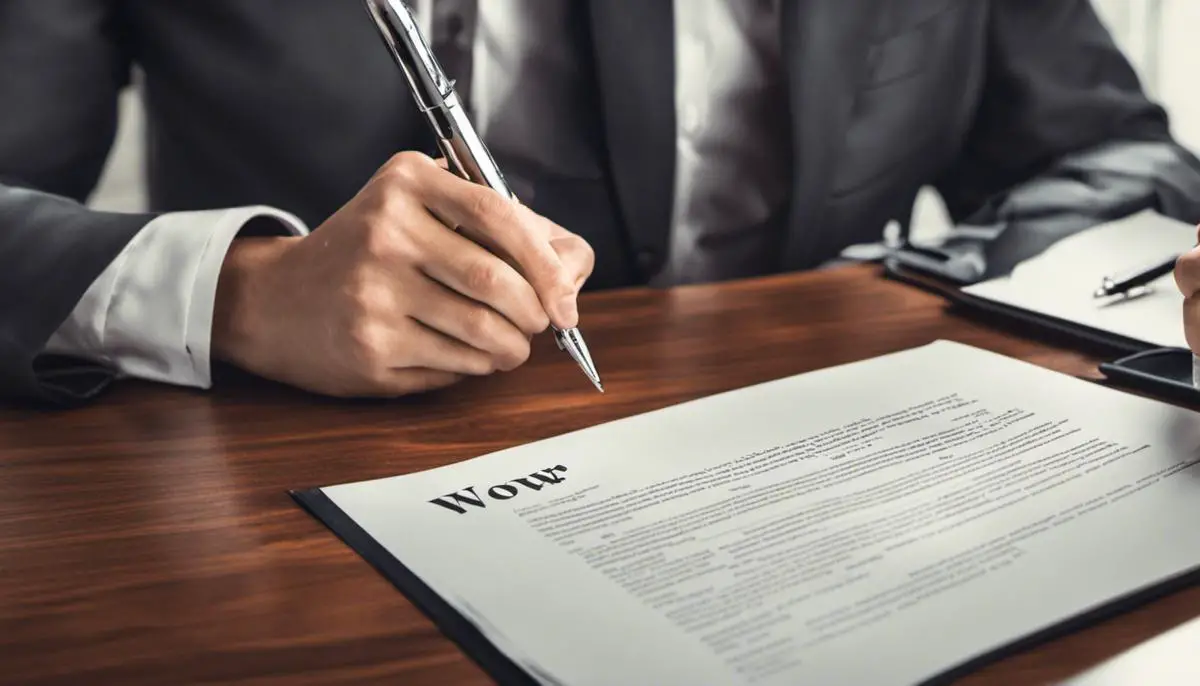Mastering the art of drafting an engaging cover letter could be the key difference between landing that dream job or being ignored. This process begins with grasping the fundamentals of a cover letter, which includes understanding its purpose, knowing the structure, and identifying the essential information to incorporate. After the initial writing, an important phase of self-review follows; you judiciously examine the letter for grammatical errors, punctuation mistakes, and checking whether your sentences are well-structured and logical to ensure clarity and improve the readability of your cover letter. It doesn’t stop there; seeking external feedback from a trusted source can help you catch errors and awkwardness in phrasing you initially missed, enabling you to upgrade your cover letter to meet the standards of potential employers.
Understanding the Basics of a Cover Letter
Step One: Understanding What a Cover Letter Entails
Becoming well-versed with the concept of a cover letter is the first step in editing one effectively. A cover letter’s major purpose is to introduce yourself to a potential employer, providing a snapshot of your qualifications and explaining why you’re a suitable candidate for the job. It accompanies your resume/application and allows you to provide details that may not be included therein. A standard cover letter contains four main sections: introduction, body, conclusion, and contact information.
Comprehend the Purpose of a Cover Letter
Initially, know that your cover letter serves as your first impression to the hiring manager. It outlines your qualifications, illuminates your personality, and provides a preview of how you communicate in writing. Ideally, it should spark the employer’s interest in you and encourage them to explore your resume and possibly invite you for an interview.
Understanding the Structure of a Cover Letter
The next step involves understanding the structure of a cover letter. It normally starts with an introductory paragraph where you mention the position you’re applying for and where you found the job posting. This is followed by the body, which is typically one to two paragraphs detailing your qualifications and explaining how they align with the job’s requirements. Then comes the conclusion, a concise paragraph summarizing the main points, expressing your interest in the role, and thanking the reader. Lastly, your contact information, including your name, address, phone number, and email address is provided at the end or the top of the letter.
Identify the Necessary Information to Include
The information you should include in your cover letter is anything that will help you stand out as the right candidate for the job. This typically includes your skills and experiences that directly relate to the requirements stated in the job description. Focus on information that might not be clearly illustrated in your resume – for instance, explaining a relevant personal project or a successful teamwork experience.
All this knowledge will enable you to understand what needs to be changed or adjusted when you arrive at the editing phase. Making sure that your cover letter embodies its purpose, structure, and necessary information is key to ensuring it leaves a lasting impression on potential employers.

Self-Review and Revision
Editing a Cover Letter: Looking for Grammar and Punctuation Mistakes
After writing your cover letter, an essential next step involves reviewing your document for grammatical errors and punctuation inaccuracies. This step requires attention to detail and vigilance. Put every sentence under the microscope, examining each word and punctuation mark. Thorough proofreading helps remove any grammatical inaccuracies, misspelled words, or punctuation mistakes, ensuring your cover letter reads smoothly.
Evaluating Sentence Structure and Logic in Your Cover Letter
Aside from grammar and punctuation, another critical characteristic of a good cover letter is well-structured and logical sentences. Every sentence should have a clear motive and contribute to your overall message. During self-review, scrutinize each sentence for clarity and make sure each one conveys your intended point without confusion. Illogical or rambling sentences can distract from your main ideas, so always check to ensure that your sentences are unified, coherent, and logically structured.
Importance of Clarity for Ease of Reading
The overall clarity of your cover letter plays a significant role in how easy or difficult it will be for the hiring manager to read and understand it. Remember, the person reading your letter is likely very busy and will appreciate a clear and concise message. During self-review, keep an eye on long, winding sentences and overly complex phrases. If you can say something in fewer words or in a simpler way, do it. Simplicity and brevity can greatly enhance the readability of your cover letter and increase your chances of making a favorable impression.
Optional: Including Headings for Organization
If you wish to incorporate headings into your cover letter, this practice can enhance organization and readability. Appropriately used, headings break your text into manageable sections, guide the reader’s eye, and help quickly communicate the content of each paragraph or group of paragraphs. If used, ensure these headings are brief, precise, and accurately represent the content of their respective sections.

Feedback and Adjustment
Importance of a Second Opinion in Cover Letter Editing
Having an extra set of eyes on your written work, especially something as critical as a cover letter, is of extreme importance. Individuals other than the author can provide a fresh perspective and may catch errors, awkward phrases, or misconceptions that were previously missed. This is a critical step in ensuring the overall flow, coherence, and correctness of your cover letter.
Feedback Reception and Implementation
Once you’ve received feedback from your chosen reviewer, take the time to carefully review their suggestions and thoroughly analyze your cover letter. Look for the specific sections or lines they’ve pointed out and make the applicable corrections. This may include rectifying grammatical errors, reconstructing awkward sentences, or re-articulating unclear points for better comprehension.
Necessity of Multiple Edit Rounds
After making these adjustments, it’s recommended to go through further rounds of feedback and edits. The process of critique and modification can be iterative, requiring several reviews before reaching a satisfying final product. Remember, your cover letter is often the first representation of you that potential employers see. Therefore, spending adequate time to perfect it can have significant payoffs.
Benefit of Professional Editing Services
If feasible, consider engaging professional editing services to review and polish your cover letter. These experts have extensive experience in crafting impactful and error-free documents. Whether you choose to engage professional services or ask a trusted friend or mentor, getting external feedback tremendously improves the quality and presentation of your cover letter.
Final Touches
Don’t neglect the application of format and design elements in your cover letter. Once content edits are complete, focus on the presentation. Make sure the alignment, spacing, font, and overall design align with professional standards. Remember, first impressions matter, and the aesthetics of your cover letter can contribute to a positive impression.

Final Review and Proofreading
Step 1: Reading Through Your Cover Letter
Before making any changes, review your cover letter in its entirety. It’s beneficial to read it aloud so you can hear how it sounds. It ensures that you give the document your full attention and can identify errors more easily. Note the spelling, punctuation, and grammatical errors, as well as phrases or sentences that can be clearer.
Step 2: Proofreading
After a general read-through, conduct a more in-depth review for potential errors. Check to ensure your verbs are in the correct tense, and that pronouns match their antecedents. Use spellcheck tools to catch spelling errors but also be wary of homophones and other word usage mistakes that may not be detected by automatic tools.
Step 3: Formatting Check
Examine the formatting of your document for consistency. This includes font style and size, paragraph alignment, header and footer content, bullet or number styles for lists, and a consistent usage of bold, italics, and underlines where necessary. Make sure there is enough white space to make the document easy to read, but not so much that it looks sparse or incomplete.
Step 4: Verifying Contact Information
Review your contact information to ensure that it’s correct. It is crucial that hiring managers have the correct information to get in touch with you. Check that your phone numbers are correctly written and active, your email address is correct and professional, and your physical mailing address is accurate, if necessary.
Step 5: Reviewing Content Relevance
Reread your cover letter to ensure that the content of each paragraph aligns with the purpose of your application. Each paragraph should contain relevant information that is directed towards the job you’re applying for. Check to see if there is a clear connection between the skills and experiences you’ve highlighted and the job requirements.
Step 6: Final Review
Once you’ve completed the steps above, do a final review of your cover letter. This last check should catch any lingering issues and confirm that your content is ready to go. During this stage, also ensure that your cover letter presents you in a positive and professional light. It should not only highlight your qualifications but also convey your enthusiasm for the job opportunity.
Step 7: Get a Second Opinion
After revising, ask a trusted person to read the cover letter. They can offer fresh perspectives on any areas that might need clarifying, and they can also check the letter for typographical and grammatical errors. You can then make the necessary changes based on their feedback before you submit it.

After you have made necessary changes recommended in the feedback, your cover letter gets closer to perfection. The critical final step before submission involves a detailed revisit of your reworked cover letter. Meticulous proofreading to confirm content accuracy, double-check formatting consistency, and validate your contact information is all part of this process. This final step’s main objective is to ensure your cover letter is error-free, polish your presentation and ultimately set you up for prospective employers’ positive recognition. Even though this might sound demanding, adapting to this process will give your cover letter the professional touch it needs to stand out in a competition-intensive job market.
